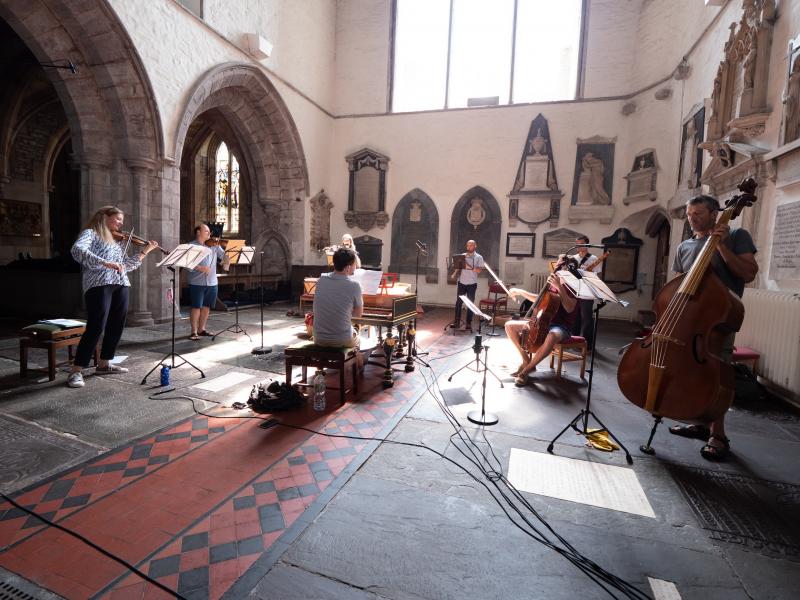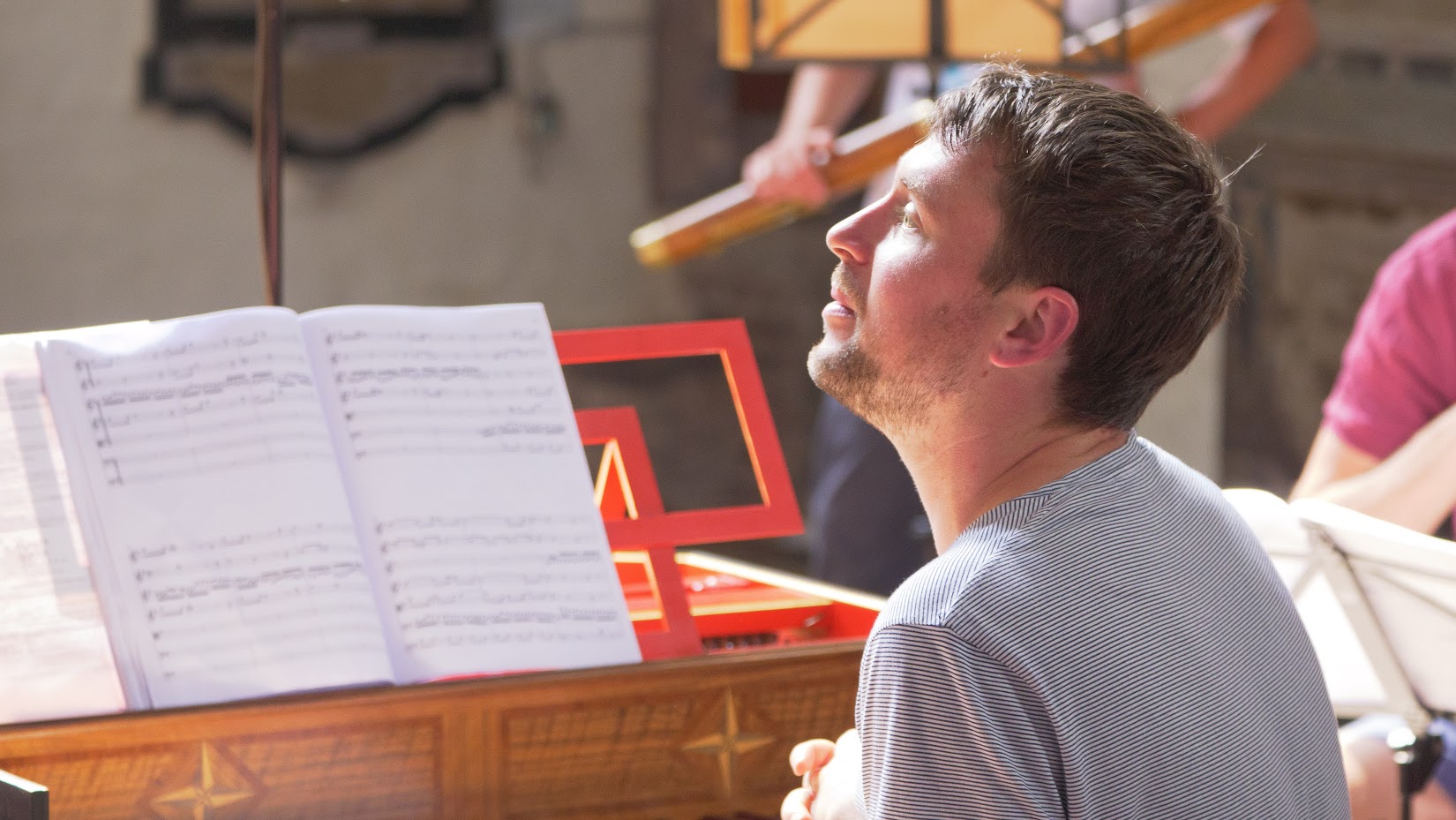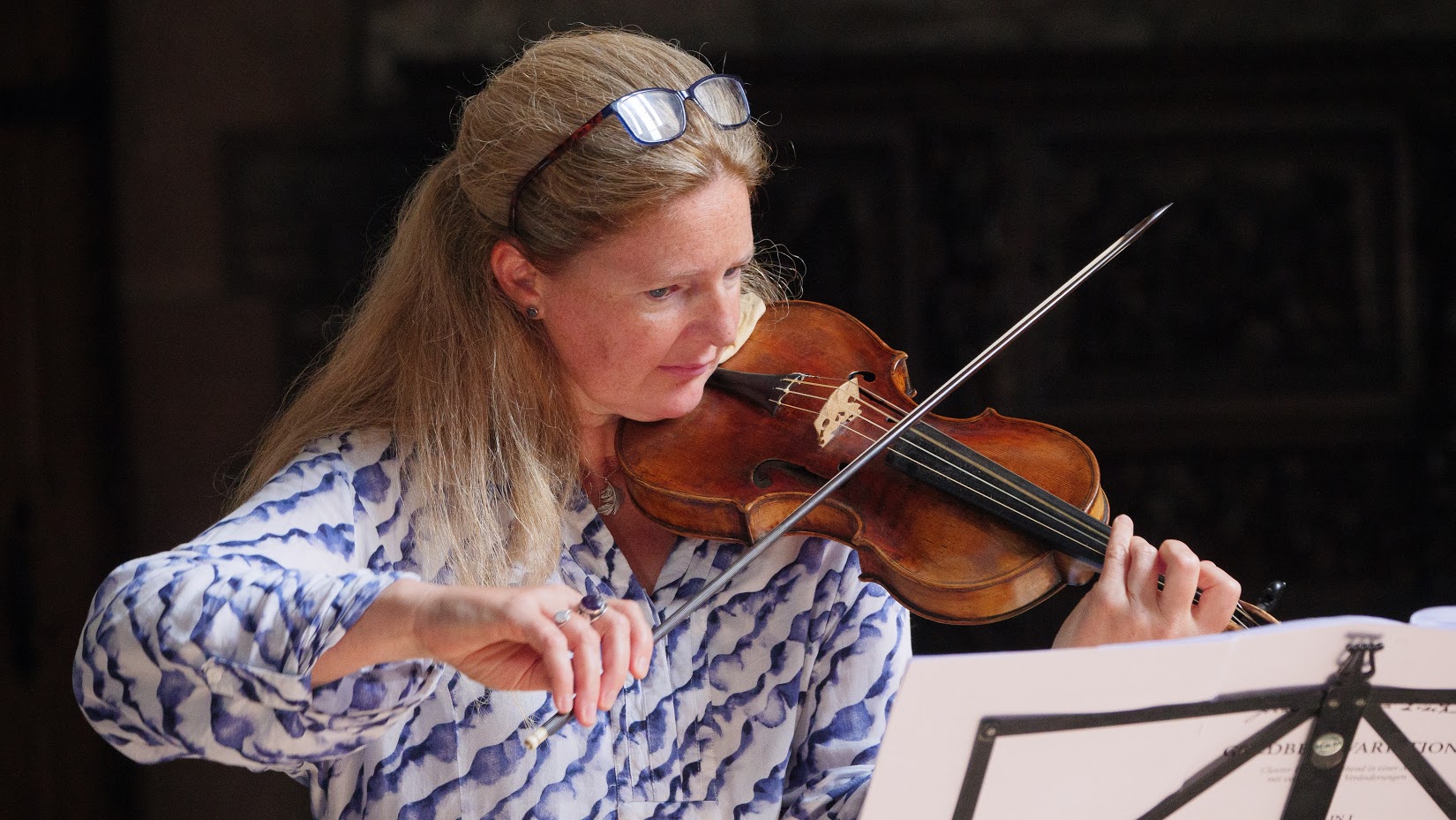Brecon Baroque, Podger, Brecon Cathedral online review - Bach recoloured | reviews, news & interviews
Brecon Baroque, Podger, Brecon Cathedral online review - Bach recoloured
Brecon Baroque, Podger, Brecon Cathedral online review - Bach recoloured
Revealing Goldbergs arrangement superbly played

Bach’s Goldberg Variations, written for harpsichord in about 1741 supposedly (or perhaps not) for a certain Johann Goldberg to play to the insomniac Count Keyserlingk, have enjoyed – or suffered – countless arrangements for other instruments, including jazz trio (Jacques Loussier), string trio with electronics, and viol consort.
Harpsichord music is hard to transcribe effectively. The instrument often works with quite thin textures that sound fine on this buzzing creature but can feel incomplete in an ensemble. For instance, Bach’s very first variation is a two-part invention, and there are others like it. No 11 is in two parts with crossing lines (played on two manuals) that present a problem of range for (say) flute and violin, which was Kelly’s choice here. Other variations, with (virtually speaking) more complex textures, need filling out here and there because of Bach’s well-known habit of implying lines and harmonies but not writing them (think of the cello suites).
Kelly’s versions throughout show him to be a consummate musician (picuteed below) with a complete understanding of – to put it bluntly – what Bach left out. The arrangement adds many absent lines and harmonic details, and makes octave transpositions, but I never once detected anything that jarred or felt wrong. No Busoni-isms. This is an intelligent version that brings the work within the scope of some of our best Bach players, and to object to it on some imaginary purist grounds would be frankly absurd. It also makes the piece less austere, dare one even say less monotonous, because of the variety of colour and the sheer expressive range of these instruments, compared to the harpsichord, whose expressive range often seems hardly to stray from the fingers up even as far as the elbows.  It’s here, though, that questions arise about this new transcription. But I must be careful. The recording was made on several days in August in the south transept of the cathedral, an echoey environment in, presumably, an empty building, and with the players unnaturally spaced. Not that there were ensemble problems; I heard none. The only even remotely arguable disagreements had to do with ornamentation. For instance, in a canonic movement, where two (or more) instruments are supposedly playing in exact imitation, one might expect them to ornament the same, which Podger and co didn’t always do. But then, they would probably argue, an ornament that works on the flute might not be right on the cello. This is a built-in chamber music problem, one that doesn’t concern a harpsichordist.
It’s here, though, that questions arise about this new transcription. But I must be careful. The recording was made on several days in August in the south transept of the cathedral, an echoey environment in, presumably, an empty building, and with the players unnaturally spaced. Not that there were ensemble problems; I heard none. The only even remotely arguable disagreements had to do with ornamentation. For instance, in a canonic movement, where two (or more) instruments are supposedly playing in exact imitation, one might expect them to ornament the same, which Podger and co didn’t always do. But then, they would probably argue, an ornament that works on the flute might not be right on the cello. This is a built-in chamber music problem, one that doesn’t concern a harpsichordist.
No, the one real problem was balance. Kelly uses strings (with double bass), flute, oboe and bassoon, plus of course harpsichord continuo, excellently played here by Kelly himself. Nothing very unusual about that, you might say. Yet in movements where strings and wind combined, the strings invariably came off worse. There were even times when, with for instance flute and violin duetting, the violin was barely audible, though nearer the camera and perhaps the microphone.  When, maybe unwisely, Kelly brought in that sublime ruffian the oboe da caccia (in variation 15), it became a command performance with the other instruments nowhere. In several variations the bass felt heavy. Whether these were issues of recording, transmission or instrumentation is hard to say; probably something of all three. But either way I would furlough the hunting oboe.
When, maybe unwisely, Kelly brought in that sublime ruffian the oboe da caccia (in variation 15), it became a command performance with the other instruments nowhere. In several variations the bass felt heavy. Whether these were issues of recording, transmission or instrumentation is hard to say; probably something of all three. But either way I would furlough the hunting oboe.
The playing throughout was beyond praise. But there were specially unforgettable moments, even (in Rossini-speak) quarts d’heure. Katy Bircher’s flute in the long, profoundly beautiful variation 13 was exquisitely refined, with a perfection of line and embellishment that surely no harpsichord could beat. Leo Duarte had, shall we say, an interesting time with the oboe da caccia, but plenty of compensation on the common or garden oboe elsewhere.
Rachel Podger (pictured above) was, as ever, a live wire, energising the performance, playing as if the violin were an extension of her arm and, no doubt, her soul. The G minor variation 25, arranged straight for string trio, was exemplary, wonderfully supported by Jane Rogers (viola) and the cellist Alex Rolton. Just occasionally I missed the harpsichord. The final variation, a kind of boxing match between the two hands on three-note chords, needs that visual excitement translated into sound. The ensemble for once couldn’t compete. But it more than made up for it elsewhere.
rating
Explore topics
Share this article
The future of Arts Journalism
You can stop theartsdesk.com closing!
We urgently need financing to survive. Our fundraising drive has thus far raised £49,000 but we need to reach £100,000 or we will be forced to close. Please contribute here: https://gofund.me/c3f6033d
And if you can forward this information to anyone who might assist, we’d be grateful.

Subscribe to theartsdesk.com
Thank you for continuing to read our work on theartsdesk.com. For unlimited access to every article in its entirety, including our archive of more than 15,000 pieces, we're asking for £5 per month or £40 per year. We feel it's a very good deal, and hope you do too.
To take a subscription now simply click here.
And if you're looking for that extra gift for a friend or family member, why not treat them to a theartsdesk.com gift subscription?
more Classical music
 Classical CDs: Hamlet, harps and haiku
Epic romantic symphonies, unaccompanied choral music and a bold string quartet's response to rising sea levels
Classical CDs: Hamlet, harps and haiku
Epic romantic symphonies, unaccompanied choral music and a bold string quartet's response to rising sea levels
 Kolesnikov, Tsoy / Liu, NCPA Orchestra, Chung, Edinburgh International Festival 2025 review - transfigured playing and heavenly desire
Three star pianists work wonders, and an orchestra dazzles, at least on the surface
Kolesnikov, Tsoy / Liu, NCPA Orchestra, Chung, Edinburgh International Festival 2025 review - transfigured playing and heavenly desire
Three star pianists work wonders, and an orchestra dazzles, at least on the surface
 BBC Proms: Láng, Cser, Budapest Festival Orchestra, Iván Fischer review - idiomatic inflections
Bartók’s heart of darkness follows Beethoven’s dancing light
BBC Proms: Láng, Cser, Budapest Festival Orchestra, Iván Fischer review - idiomatic inflections
Bartók’s heart of darkness follows Beethoven’s dancing light
 Weilerstein, NYO2, Payare / Dueñas, Malofeev, Edinburgh International Festival 2025 review - youthful energy and emotional intensity
Big-boned Prokofiev and Shostakovich, cacophonous López, plus intense violin/piano duo
Weilerstein, NYO2, Payare / Dueñas, Malofeev, Edinburgh International Festival 2025 review - youthful energy and emotional intensity
Big-boned Prokofiev and Shostakovich, cacophonous López, plus intense violin/piano duo
 theartsdesk at the Three Choirs Festival - Passion in the Cathedral
Cantatas new and old, slate quarries to Calvary
theartsdesk at the Three Choirs Festival - Passion in the Cathedral
Cantatas new and old, slate quarries to Calvary
 BBC Proms: Estonian Philharmonic Chamber Choir, Kaljuste review - Arvo Pärt 90th birthday tribute
Stillness and contemplation characterise this well sung late-nighter
BBC Proms: Estonian Philharmonic Chamber Choir, Kaljuste review - Arvo Pärt 90th birthday tribute
Stillness and contemplation characterise this well sung late-nighter
 BBC Proms: Kholodenko, BBCNOW, Otaka review - exhilarating Lutosławski, underwhelming Rachmaninov
Polish composers to the fore in veteran conductor’s farewell
BBC Proms: Kholodenko, BBCNOW, Otaka review - exhilarating Lutosławski, underwhelming Rachmaninov
Polish composers to the fore in veteran conductor’s farewell
 theartsdesk at the Pärnu Music Festival 2025 - Arvo Pärt at 90 flanked by lightness and warmth
Paavo Järvi’s Estonian Festival Orchestra still casts its familiar spell
theartsdesk at the Pärnu Music Festival 2025 - Arvo Pärt at 90 flanked by lightness and warmth
Paavo Järvi’s Estonian Festival Orchestra still casts its familiar spell
 BBC Proms: Batsashvili, BBC Scottish Symphony Orchestra, Ryan Wigglesworth review - grief and glory
Subdued Mozart yields to blazing Bruckner
BBC Proms: Batsashvili, BBC Scottish Symphony Orchestra, Ryan Wigglesworth review - grief and glory
Subdued Mozart yields to blazing Bruckner
 Classical CDs: Hens, Hamburg and handmaids
An unsung French conductor boxed up, plus Argentinian string quartets and baroque keyboard music
Classical CDs: Hens, Hamburg and handmaids
An unsung French conductor boxed up, plus Argentinian string quartets and baroque keyboard music
 BBC Proms: McCarthy, Bournemouth SO, Wigglesworth review - spring-heeled variety
A Ravel concerto and a Walton symphony with depth but huge entertainment value
BBC Proms: McCarthy, Bournemouth SO, Wigglesworth review - spring-heeled variety
A Ravel concerto and a Walton symphony with depth but huge entertainment value
 BBC Proms: First Night, Batiashvili, BBCSO, Oramo review - glorious Vaughan Williams
Spirited festival opener is crowned with little-heard choral epic
BBC Proms: First Night, Batiashvili, BBCSO, Oramo review - glorious Vaughan Williams
Spirited festival opener is crowned with little-heard choral epic

Add comment